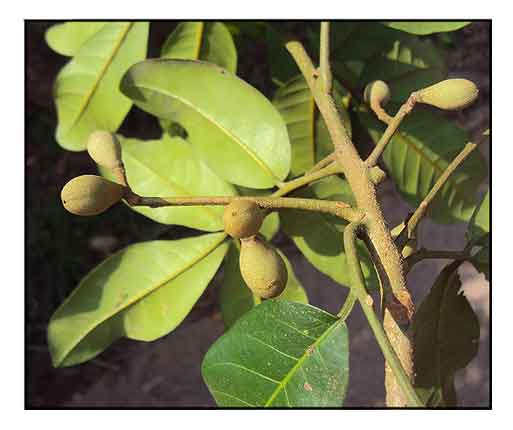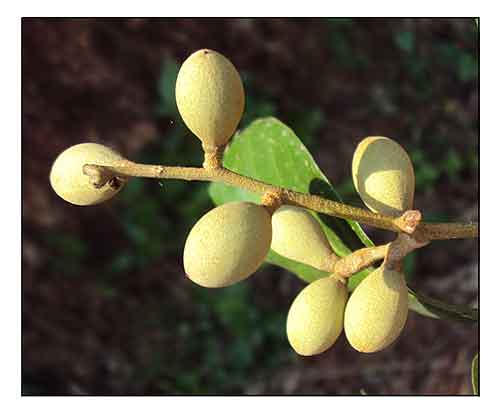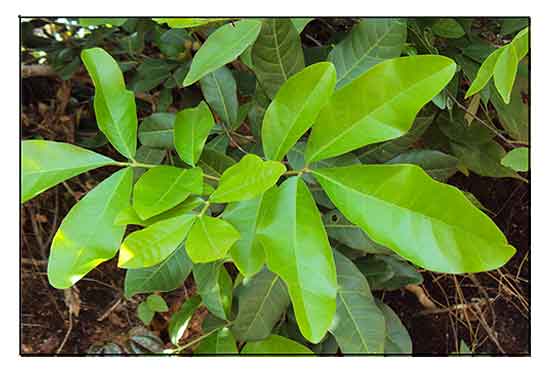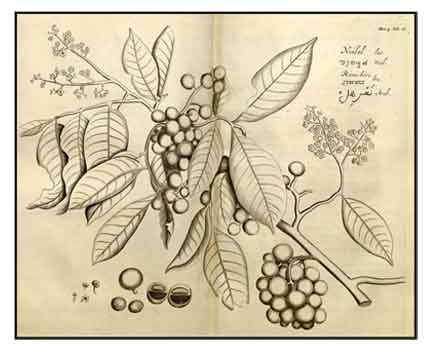 Gen info Gen info
- Aglaia Lour. is the largest genus of the subtropical and tropical angiosperm family Meliaceae (order Sapindales), containing at least 105 (115) arborescent species and has presented more taxonomic problems in species delineation than any other genus of the family. (4)
Botany
Aglaia elaeagnoidea is an evergreen tree, 1.5-15 m tall, to 30 cm d.b.h. Bark greenish white or russet, thin, exfoliating. Young branches, petioles, rachises, and inflorescences covered with scalelike stellate rust-colored trichomes, densely brown squamate and glabrescent, or densely silvery to yellowish stellate squamate. Leaves alternate to subopposite, 10-20 cm; petiole and rachis 3-10 cm, brown squamate, covered with scalelike stellate rust-colored trichomes when young but glabrescent; leaflets (1 or)3-7, opposite to subopposite; petiolules 2-13 mm, brown squamate; leaflet blades obovate, elliptic, or oblong-elliptic, (3-)6-12(-16) × (1.5-)2.5-5.5 cm, thinly papery to leathery, both surfaces glabrous or abaxially densely yellowish squamate and adaxially densely silvery squamate but abaxially sparsely lepidote along midvein, abaxially greenish yellow when dry, adaxially lustrous, midvein abaxially prominent and adaxially slightly prominent, secondary veins 5-10 on each side of midvein, slender, and abaxially ± prominent, base cuneate to broadly cuneate and ± oblique, margin entire, apex acuminate, obtuse, or rounded. Thyrses axillary, as long as or slightly shorter than leaves, lax, covered with rust-colored or yellowish scalelike stellate trichomes or densely russet squamate. Flowers ca. 2.5 mm in diam. Pedicel ± as long as flower, covered with scalelike stellate rust-colored trichomes. Calyx ca. 0.6 mm, 5-lobed; lobes rounded, outside rust-colored or yellowish lepidote. Petals 5, oblong, 1-1.5 mm, glabrous or outside yellowish lepidote, apex rounded. Staminal tube subglobose, slightly shorter than petals, apical margin entire, undulate, or 5-lobed; anthers 5, included. Ovary ovoid, densely covered with scalelike stellate trichomes; stigma sessile. Infructescences axillary, 1-3 cm, usually with 1(-3) fruit, brown squamate; bractlets conical. Fruit indehiscent, yellowish brown when mature, subglobose, ellipsoid, or obovoid, 1-1.4 cm in diam.; persistent calyx 5-crenate, crenations triangular, brown squamate. Seeds 1(or 2) per fruit. (Flora of China @ efloras.org) (2)
 Aglaia elaeagnoidea is a shrub or small tree, up to 20 m. Leaves are compound, about 6-30 cm long, with 1-3 pairs of leaflets. Leaflet is leathery, elliptic to slightly obovate shaped, 5-12 cm long and 2-4.5 cm wide, with tapering or blunt tip and an asymmetric base. Upper surface of leaflets is covered with pale orange-brown fringed scales. Scales also occurs at the petiole, leaf axis, calyx, inflorescences and young branches. Male inflorescence is 9-34 cm, longer compared to female inflorescence which is up to 12 cm long. Flower is about 3 mm diameter and comprises of 5 petals and 5 protruding anthers. Fruit is slightly flattened globose shaped (1.5 cm in diameter), covered in dense orange-brown scales, like the branches. Fruit does not split open unless external force is exerted. Each fruit contains 1-2 seeds. Each seed is about 10 mm long and 6 mm wide, and completely covered in white fleshy aril. (16) Aglaia elaeagnoidea is a shrub or small tree, up to 20 m. Leaves are compound, about 6-30 cm long, with 1-3 pairs of leaflets. Leaflet is leathery, elliptic to slightly obovate shaped, 5-12 cm long and 2-4.5 cm wide, with tapering or blunt tip and an asymmetric base. Upper surface of leaflets is covered with pale orange-brown fringed scales. Scales also occurs at the petiole, leaf axis, calyx, inflorescences and young branches. Male inflorescence is 9-34 cm, longer compared to female inflorescence which is up to 12 cm long. Flower is about 3 mm diameter and comprises of 5 petals and 5 protruding anthers. Fruit is slightly flattened globose shaped (1.5 cm in diameter), covered in dense orange-brown scales, like the branches. Fruit does not split open unless external force is exerted. Each fruit contains 1-2 seeds. Each seed is about 10 mm long and 6 mm wide, and completely covered in white fleshy aril. (16)
Distribution
- Native to the Philippines.
- Common in coastal areas; also in primary or secondary, deciduous or evergreen inland forests up to 1100 m altitude.
- Also native to Andaman Is., Assam, Bangladesh, Borneo, Cambodia, China, Hainan, India, Jawa, Laos, Lesser Sunda Is., Malaya, Maluku, New Caledonia, New Guinea, Queensland, Samoa, Sri Lanka, Sulawesi, Sumatera, Taiwan, Thailand, Vanuatu, Vietnam., Western Australia. (1)
 Constituents Constituents
- Study of bark isolated two new rocaglamides, 8b-O-5-oxohexylrocaglaol (1) and elaeagnin (2), together with 12 known compounds. (see study below) (3)
- Phytochemical screening of crude extracts of leaf and stem with different solvents (chloroform, ethanol, methanol, petroleum ether, and water) yielded alkaloids, steroids, phenols, flavonoids, tannins, coumarins, quinones, xanthoproteins, terpenoids, carbohydrates, fatty acids, leucoanthocyanins, saponins, and emodins.
(see study below) (3)
- Study of bark isolated one 1H-cyclopentatetrahydro[b]benzofuran, two lignans, two dammarane triterpenoids and one limonoid. (8)
- Study of ethanolic extract of fruits yielded
carbohydrate and terpenoids, with absence of alkaloid, steroid, tannin, flavonoids, saponins, coumarins, phenol, carboxylic acid, amino acids, resins, and quinone. (9)
- Study of ethyl acetate extract of stem bark yielded five compounds. Compounds 1 and 2 were identified as eudesmane-type sesquiterpenoids, 5-epi-eudesm-4(15)-ene-1ß,6ß-diol (1) and 6α-hyrdroxy-eudesm-4(15)en-1-one (2). Compounds 3-5 were identified as dammarane-type triterpenoids, 20S,24S-epoxy-25-hydroxydammarane-3-one (3), 20S,24S-epoxydammarane-3α,25-diol (4), and 3α-epi-cabraleahydroxy lactone (5). (see study below) (12)
- GC-MS study evaluated bark and leaf of A. elaeagnoidea for bioactive components. Major compounds in the leaf were
a-Caryophyllene (13.04%), 1-Heptatriacotanol (10.74%), 9,19-Cycloergost-24(28)-en-3-ol,4,14-dimethyl-, acetate,(3a,4a,5a) (9.25%), Cholestan-3-ol,2- methylene-, (3a,17a) (9.07%), Phytol (8.42%), 12-Oxabicyclo [ 9.1.0.]dodeca-3,7- diene,1,5,5,8-tetramethyl-, [IR-(IR*,3E,7E,11R*]- (5.54%). The bark yielded squalene (16.56%), trans-Z-a-bisabolene epoxide (13.50%), 7-hexadecenal, (Z) (6.79%),imidazole 2-amino-5-[(2-carboxy)vinyl] (6.56%), 8,11,14-eicosatrienoic acid (Z,Z,Z) (5.83%). These constituents provides support for antitumor, analgesic, antihypertensive and anti-inflammatory properties of the plant. (14)
Properties
- Studies have suggest cytotoxic, anticancer, bronchodilating, antioxidant, antimicrobial, wound healing, phytoremediative, mosquito larvicidal properties.
Parts used
Fruit, seeds, bark, flowers, leaves.
 Uses Uses
Edibility
- Fruits are edible. White aril is edible and sweet tasting.
Folkloric
- No reported folkloric medicinal use in the Philippines.
-
In Ayurveda, used as astringent, antidiarrheal, antidysenteric and for treatment of skin diseases and tumors. (5)
- In Nepal, fruit used for treatment of leprosy.
- In Nepal and India, fruits used to treat inflammatory diseases and febrile complaints. Seeds used for relieving painful urination. (15)
Others
- Fermentation initiator: Used by folk practitioners as source of fermentation initiators in the preparation of alcohol fermentation products. (9)
- Wood: Wood is hard, bright red. Used for house construction.
Studies
• Cytotoxicity / Bark: Study of bark isolated two new rocaglamides, 8b-O-5-oxohexylrocaglaol (1) and elaeagnin (2), together with 12 known compounds. Three rocaglamide derivatives, dehydroaglaiastatin (13), 8b-O-5-oxohexylrocaglaol (1) and rocaglaol (5) exhibited significant cytotoxic activity against HepG2 human liver cancer cells with IC50s of 0.69, 4.77 and 7.37 µM. respectively. (3)
• Antioxidant / Antimicrobial / Leaf and Stem Bark: In vitro antioxidant activity of ethanolic extracts of leaf and bark exhibited maximum phenolic compounds and scavenging activity. Phenolic compounds of leaf and bark showed positive correlation to antioxidant activity. All crude extracts of leaf and bark showed low to moderate inhibition zones against Staphylococcus aureus, Bacillus subtilis, Escherichia coli, Vibrio vulnificus, and Candida albicans. Crude extracts of bark showed greater antioxidant and antimicrobial activity than leaf extracts. (5)
• Silver and Gold Nanoparticles / Waste Water Treatment / Flowers: Study reports on the easy, rapid, non-toxic, energy-efficient, cost-effective synthesis of gold and silver nanoparticles using flower extract of Aglaia elaeagnoidea. Results suggest potential for application of biosynthesized Ag and AuNPs as nanocatalyst in waste water treatment. (6)
• Silver and Gold Nanoparticles / Mosquito Nanolarvicides: Study reports on the Priyangu-mediated synthesis of Ag nanoparticles toxic to Culex quinquefasciatus, Aedes aegypti, and Anopheles stephensi. The plant extract and nanolarvicide were tested on the three mosquito vectors and on three non-target mosquito predators. Priyangu extract exhibited moderate toxicity while the Priyangu-synthesized AgNPs were highly toxic to Cx. quinquefasciatus (LC50 24.91, LC90 45.96 µg/mL), Ae. aegypti (LC50 22.80, LC90 43.23 µg/mL), and An. stephensi (LC50 20.66, LC90 39.94 µg/mL). The extract and AgNPs were found safer to non-target larvivorous fishes, backswimmers, and waterbugs, with LC50s ranging from 1247 to 37,254.45 µg/mL, if compared to target pests. (7)
• Nutritional Value / Fruits: Fruits yield carbohydrates and terpenoid compounds. Wild edible fruits possess nutritional factors carbohydrates (57.10%), proteins (52.78%), and fat (0.08%), along with antioxidant property by DPPH assay. (see constituents above) (9)
• Copper Oxide Nanoparticles / Catalytic / Flowers: Study reports on a phytogenic synthesis using flower extract for a highly active, recoverable, and recyclable heterogenous copper oxide nanocatalyst encapsulated within biomaterial that acts as a nontoxic and renewable source of reducing and stabilizing agent. The CuO NPs showed great potential in reduction of pernicious dyes and nitro organic pollutants in water. (10)
• Lupeol / Antiasthmatic / Bronchodilating / Fruit Pulp: Study evaluated the bronchodilating effect of lupeol isolated from the fruit pulp of Aglaia elaeagnoidea using isolated goat trachea chain preparation. The lupeol isolated from fruit pulp of Aglaia elaeagnoidea inhibited the contractile effect of histamine (p<0.05) on histamine-induced contraction in isolated goat tracheal chain. (11)
• Anticancer / Terpenoids / Stem Bark: Study of stem bark isolated five compounds, which were tested for cytotoxicity against HeLa cervical cancer and DU145 prostate cancer cells. Compound 4, 20S,24S-epoxydammarane-3α,25-diol, showed stronger activity compared to other compounds. (see constituents above) (12)
• Wound Healing / Dead Space and Burn Wound / Ointment Formulation / Leaves: Study evaluated the wound healing potential of ethanolic extract ointment of Aglaia elaeagnoidea in dead space and burn wounds. Results showed significant healing (p<0.01) in all wound models. All parameters such as wound contraction showed significant (p<0.01) changes compared to control. (13)
Availability
Wild-crafted. |

![]()







